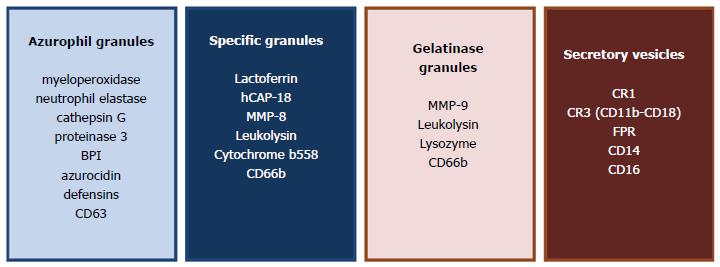Copyright
©The Author(s) 2015.
World J Crit Care Med. Aug 4, 2015; 4(3): 179-191
Published online Aug 4, 2015. doi: 10.5492/wjccm.v4.i3.179
Published online Aug 4, 2015. doi: 10.5492/wjccm.v4.i3.179
Figure 5 Components of neutrophil granules.
The second mechanism of bacterial killing is mediated by enzymes stored in granules. Essential serine proteases stored in primary granules include NE, cathepsin G and proteinase 3. Other bactericidal proteins of primary granules include defensins, azurocidin and bactericidal permeability-increasing (BPI) protein, which mutually function to destabilise bacterial membranes. Additional antibacterial proteins stored in secondary or specific granules include lactoferrin, the 18-kDa human cathelicidin antimicrobial protein (hCAP18) and lysozyme. Lactoferrin, an iron binding protein displays antimicrobial properties by limiting iron availability and exhibits direct antmicrobial and antifungal properties independent of iron-binding. LL-37, the CX-terminal peptide of hCAP-18, disrupts the integrity of bacterial membranes and can neutralise bacterial endotoxins. The gelatinase or tertiary granules contain mainly gelatinase (MMP-9) whose main function is to degrade type V collagen in the extracellular matrix to aid neutrophil migration. In addition to these three granule types, neutrophils also contain secretory vesicles that contain a reservoir of essential receptors and integrins. All are degranulated to the outside of the cell or into the phagocytic vacuole.
- Citation: Reeves EP, McCarthy C, McElvaney OJ, Vijayan MSN, White MM, Dunlea DM, Pohl K, Lacey N, McElvaney NG. Inhaled hypertonic saline for cystic fibrosis: Reviewing the potential evidence for modulation of neutrophil signalling and function. World J Crit Care Med 2015; 4(3): 179-191
- URL: https://www.wjgnet.com/2220-3141/full/v4/i3/179.htm
- DOI: https://dx.doi.org/10.5492/wjccm.v4.i3.179









